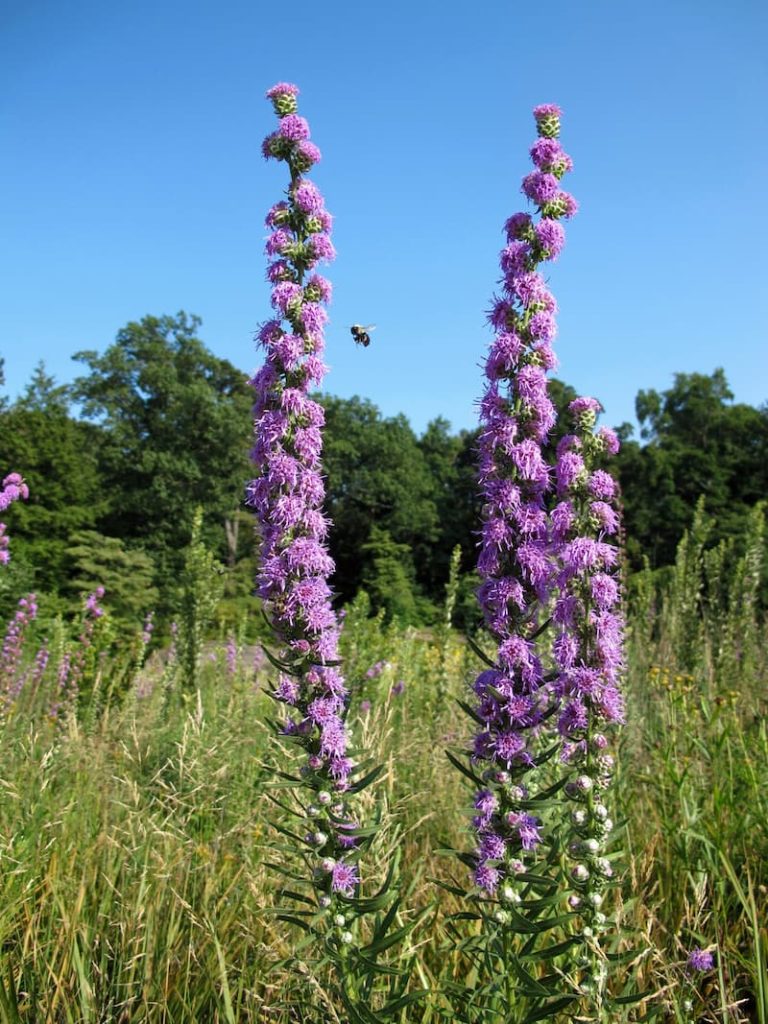Your cart is currently empty!
8 Ways On Killing Weeds Naturally
When looking at all the natural ways to kill weeds, it is always best to bring productivity and harmony to the garden.
Your cart is currently empty!
Photo:
Joshua Mayer from Madison, WI, USA, via Wikimedia Commons
Rough Blazing Star features fluffy, deep rose-purple flowers arranged in 1″ button-like heads. Blooming begins, as one would assume, at the top of the flower stalk and steadily progresses downward. The flower display continues from late summer until autumn for 3–4 weeks.
Discover more about its sister plants, the slender blazing star and the dense blazing star.
Botanical Name: Liatris aspera
Also Called: Button Blazing Star; Tall Blazing Star
En français: Liatris rugueux
See More Plants in this Botanical Family:
Colour:
Sun / Shade:
Water: Drought resistant, but watering helps develop flowers
Height:
Pollinators:
Care:
Butterflies, skippers, and bees are greatly attracted to the flowers of the Rough Blazing Star. Butterfly visitors include Monarchs, Painted Ladies, Black Swallowtails, Sulfurs, and others. This is not unlike the Dense Blazing Star.
Many other insects also visit the flowers, including bumblebees, little carpenter bees, miner bees, Leaf-Cutting bees, Green Metallic bees, and other sweat bees. Herbivores, large and small, readily eat the foliage and stems, including rabbits, deer, and groundhogs.

The rough blazing star, Liatris aspera, is an upright, clump-forming perennial growing from 2-4′ tall (less frequently to 5′) in dry soils, especially in glades, meadows, prairies, open woods, roadsides, and along railroad tracks. Typically reaching four feet in height, it can reach five to six feet in ideal conditions.
Liatris’ drought-tolerant nature makes it ideal for well-drained dry to medium soils, sandy soils, or rocky terrain. Plant it away from humid areas or locations with consistently wet soil in the winter. Despite the fact that this species of Liatris has a root system that can spread and self-sow, it is not considered an invasive species.
It is not necessary to deadhead blazing star plants because they bloom for weeks at a time. Pruning, however, the plants can encourage a second flowering after seasonal flowering has faded.
They grow in upland and loess hill prairies, glades, upland forest openings, exposed ledges and tops of bluffs, savannas, and seldom along streams; they can also grow along railroads, pastures, and roadsides.
Among the mammals that consume blazing star foliage is woodchucks, rabbits, and deer. Also, birds consume the fruits of blazing stars, such as tiny sunflower seeds. Blazing star rootstocks with sweet, thickened textures are preferred by voles and other herbivorous mammals.
Native Americans used the blazing star for a number of medicinal purposes. In addition to treating headaches, arthritis, and earaches with the roots, their roots were also used to reduce fevers, while the leaves were used for treating upset stomachs and antiseptics.
An Asteraceae (daisy) perennial, Rough Blazing Star grows from a corm. It is found in nature in hardiness zones 3 to 9, where it is a perennial. This species is commonly found in prairie glades and barren regions throughout the eastern and central US and parts of Canada. The flower spikes are showy purple and attract butterflies in late summer and fall.
When looking at all the natural ways to kill weeds, it is always best to bring productivity and harmony to the garden.
Plant Eastern Redbud for a stunning display of spring colour, and the emergence of heart-shaped leaves. Read its quick growth Guide.
Deadheading flowers is a very important job to do in the garden as it helps to increase the number of blooms on your plants.
Below are 11 flowers that bloom all summer and an tips of how they grow and where to plant them
Canada Violet produces stunning, fragrant white flowers with a purple tint for many months from summer to fall.
How do you turn your passion for landscape photography into a job? A step-by-step guide on how to make money capturing the beauty of gardens in Toronto. Where to find a job as a landscape photographer?
GardeningCalendar.ca gets some funding from advertisers. If you click on links and advertisements at no cost to you, the site may receive a small commission that helps fund its operation.
© 2025 J&S Calendars Ltd.
Leave a Reply
You must be logged in to post a comment.